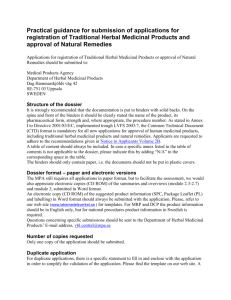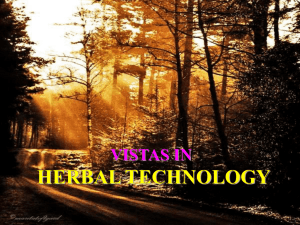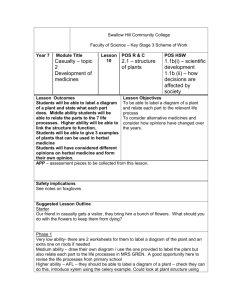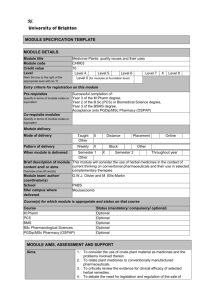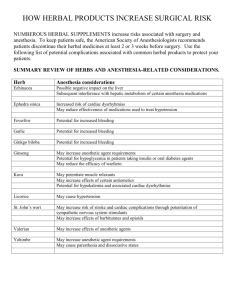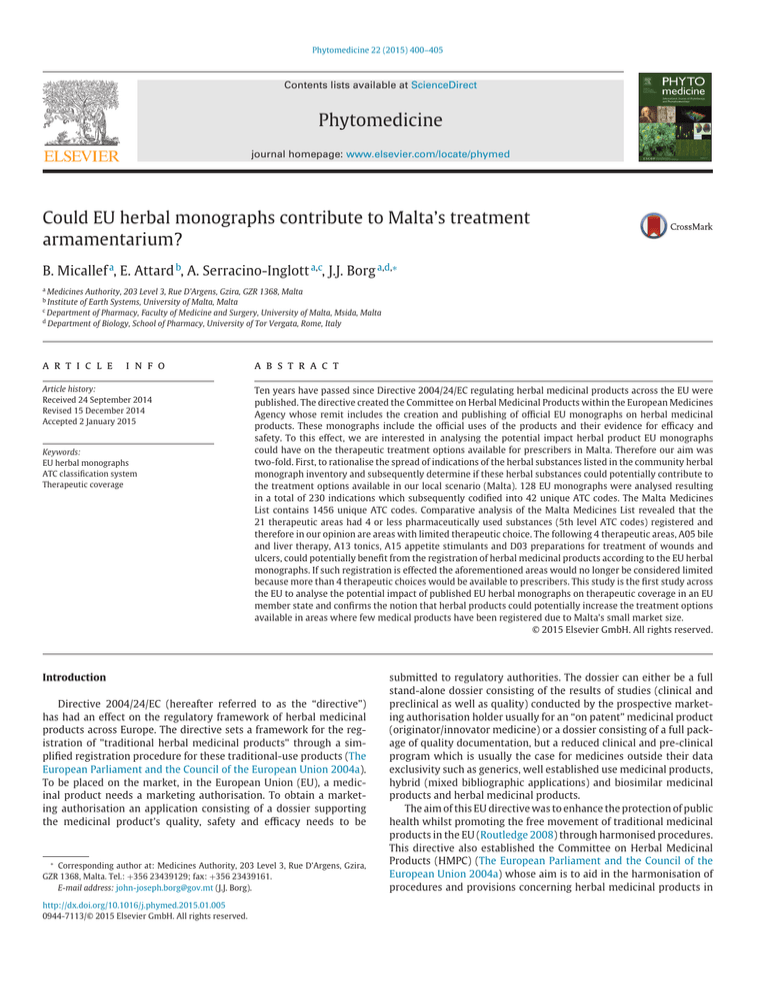
Phytomedicine 22 (2015) 400–405
Contents lists available at ScienceDirect
Phytomedicine
journal homepage: www.elsevier.com/locate/phymed
Could EU herbal monographs contribute to Malta’s treatment
armamentarium?
B. Micallef a, E. Attard b, A. Serracino-Inglott a,c, J.J. Borg a,d,∗
a
Medicines Authority, 203 Level 3, Rue D’Argens, Gzira, GZR 1368, Malta
Institute of Earth Systems, University of Malta, Malta
c
Department of Pharmacy, Faculty of Medicine and Surgery, University of Malta, Msida, Malta
d
Department of Biology, School of Pharmacy, University of Tor Vergata, Rome, Italy
b
a r t i c l e
i n f o
Article history:
Received 24 September 2014
Revised 15 December 2014
Accepted 2 January 2015
Keywords:
EU herbal monographs
ATC classification system
Therapeutic coverage
a b s t r a c t
Ten years have passed since Directive 2004/24/EC regulating herbal medicinal products across the EU were
published. The directive created the Committee on Herbal Medicinal Products within the European Medicines
Agency whose remit includes the creation and publishing of official EU monographs on herbal medicinal
products. These monographs include the official uses of the products and their evidence for efficacy and
safety. To this effect, we are interested in analysing the potential impact herbal product EU monographs
could have on the therapeutic treatment options available for prescribers in Malta. Therefore our aim was
two-fold. First, to rationalise the spread of indications of the herbal substances listed in the community herbal
monograph inventory and subsequently determine if these herbal substances could potentially contribute to
the treatment options available in our local scenario (Malta). 128 EU monographs were analysed resulting
in a total of 230 indications which subsequently codified into 42 unique ATC codes. The Malta Medicines
List contains 1456 unique ATC codes. Comparative analysis of the Malta Medicines List revealed that the
21 therapeutic areas had 4 or less pharmaceutically used substances (5th level ATC codes) registered and
therefore in our opinion are areas with limited therapeutic choice. The following 4 therapeutic areas, A05 bile
and liver therapy, A13 tonics, A15 appetite stimulants and D03 preparations for treatment of wounds and
ulcers, could potentially benefit from the registration of herbal medicinal products according to the EU herbal
monographs. If such registration is effected the aforementioned areas would no longer be considered limited
because more than 4 therapeutic choices would be available to prescribers. This study is the first study across
the EU to analyse the potential impact of published EU herbal monographs on therapeutic coverage in an EU
member state and confirms the notion that herbal products could potentially increase the treatment options
available in areas where few medical products have been registered due to Malta’s small market size.
© 2015 Elsevier GmbH. All rights reserved.
Introduction
Directive 2004/24/EC (hereafter referred to as the “directive”)
has had an effect on the regulatory framework of herbal medicinal
products across Europe. The directive sets a framework for the registration of "traditional herbal medicinal products" through a simplified registration procedure for these traditional-use products (The
European Parliament and the Council of the European Union 2004a).
To be placed on the market, in the European Union (EU), a medicinal product needs a marketing authorisation. To obtain a marketing authorisation an application consisting of a dossier supporting
the medicinal product’s quality, safety and efficacy needs to be
∗
Corresponding author at: Medicines Authority, 203 Level 3, Rue D’Argens, Gzira,
GZR 1368, Malta. Tel.: +356 23439129; fax: +356 23439161.
E-mail address: john-joseph.borg@gov.mt (J.J. Borg).
http://dx.doi.org/10.1016/j.phymed.2015.01.005
0944-7113/© 2015 Elsevier GmbH. All rights reserved.
submitted to regulatory authorities. The dossier can either be a full
stand-alone dossier consisting of the results of studies (clinical and
preclinical as well as quality) conducted by the prospective marketing authorisation holder usually for an “on patent” medicinal product
(originator/innovator medicine) or a dossier consisting of a full package of quality documentation, but a reduced clinical and pre-clinical
program which is usually the case for medicines outside their data
exclusivity such as generics, well established use medicinal products,
hybrid (mixed bibliographic applications) and biosimilar medicinal
products and herbal medicinal products.
The aim of this EU directive was to enhance the protection of public
health whilst promoting the free movement of traditional medicinal
products in the EU (Routledge 2008) through harmonised procedures.
This directive also established the Committee on Herbal Medicinal
Products (HMPC) (The European Parliament and the Council of the
European Union 2004a) whose aim is to aid in the harmonisation of
procedures and provisions concerning herbal medicinal products in
B. Micallef et al. / Phytomedicine 22 (2015) 400–405
401
Table 1
The structure of the coding system as illustrated by the complete classification of metformin.
Code
Description
Level description
A
A10
A10B
A10BA
A10BA02
Alimentary tract and metabolism
Drugs used in diabetes
Blood glucose lowering drugs, excl. insulins
Biguanides
Metformin
1st level – Anatomical main group
2nd level – Therapeutic subgroup
3rd level – Pharmacological subgroup
4th level – Chemical subgroup
5th level – Chemical substance
Adapted from WHO Collaborating Centre for Drug Statistics Methodology (2014).
EU Member States whilst further integrating herbal medicinal products in the European regulatory framework. One of the activities of the
HPMC is the preparation of Community herbal monographs, which
comprise the scientific opinion of the HMPC on the safety and efficacy1
data concerning a herbal substance and its preparations intended for
medicinal use, based on the experience of use within the community.
EU herbal monographs are intended to be used as reference material in herbal marketing-authorisation applications (both for wellestablished-use and traditional-use applications) (The European
Parliament and the Council of the European Union 2004a).
The aim of this study was therefore to investigate the potential
impact herbal product EU monographs could have on the therapeutic
treatment options available for prescribers in Malta. Our objectives
were two: (1) to rationalise the spread of indications of the herbal
substances listed in the community herbal monograph inventory; (2)
to determine if these herbal substances could potentially contribute
to the treatment options available in our local scenario (Malta). To
our knowledge, this study is the first study across the EU to analyse
the potential impact of published EU herbal monographs on therapeutic coverage in an EU member state and lends support to the
notion that herbal products could increase treatment options in areas
where few medical products have been registered due to Malta’s small
market size.
Method
Data source and inclusion criteria
All the EU monographs published by the HPMC were retrieved
from the European Medicines Agency website (European Medicines
Agency 2014). The filter function on the website was used to retrieve
herbal products for which a monograph was available. The inclusion
criteria for a monograph to be used for analysis included those monographs with the following statuses "Draft published", "Assessment
close to finalisation (pre-final)" and "Assessment finalised". A total of
128 Community herbal monographs were included in the analysis.
The final and draft EU monographs included were published between July 2006 to January 2014 and July 2011 to November 2013
respectively. All EU herbal monographs were analysed and relevant
information was compiled using Excel (Microsoft, Redmond, WA).
Data extraction and association rationale
The following data was captured: The EU Document Reference
number of the monograph; the date of HMPC adoption; the scientific name; the common name of herbal substance; the legal basis
for registration (Traditional use/Well Established Use) and all listed
indications. In addition, information on the herbal preparation and
pharmaceutical form was also captured.
1
Although the HPMC review the efficacy of an herbal medicinal product, it must
be qualified that the robustness and amount of evidence based data to prove efficacy
for a traditional herbal product is less than that for a new compound, which in turn
explains why the claims of a traditional herbal product are restricted. The efficacy of
a herbal medicinal product and a standard drug should not be treated as equivalent
unless the herbal medicinal product has undergone the same clinical development
path as a standard drug with randomised Clinical Trials.
The Anatomical Therapeutic Chemical (ATC) classification system
was used to classify the captured indications. The ATC system used
is a pharmaceutical coding system that divides drugs into different
groups according to the organ or system on which they act and their
therapeutic and chemical characteristics. Each bottom-level ATC code
stands for a pharmaceutically used substance, or a combination of
substances, in a single indication or use. It is important to note that
using this coding system one drug can have more than one ATC code
(WHO Collaborating Centre for Drug Statistics Methodology 2014).
For clarity’s sake readers should keep in mind the following principles behind the ATC classification system’s structure. The 1st level
is the anatomical area and is denoted by a single letter for example: A for “Alimentary tract and metabolism”. The 2nd level is the
therapeutic subgroup area and is denoted by two digits for example:
A10 which corresponds to "Drugs used in diabetes". The 3rd level is
the pharmacological subgroup and is denoted by a single letter for
example A10B which corresponds to "Blood glucose lowering drugs
excluding insulins". The 4th level is the chemical subgroup and is
denoted by another single letter for example A10BA which corresponds to Biguanides. Finally the 5th level or bottom level corresponds to a chemical substance or combination of substances and is
denoted by two digits (WHO Collaborating Centre for Drug Statistics
Methodology 2014). The full code therefore consists of 6 characters
(refer to Table 1).
All indications per herbal product within the EU monograph were
then subsequently analysed in order to associate an ATC code. Where
the active substance considered had a specific ATC code as was the
case for some herbal substance having a "Well-Established Use"
for example Senna code A06AB06, Cascara code A06AB07, Valerian
code N05CM09, etc. as per ATC/DDD Index 2014 (WHO Collaborating
Centre for Drug Statistics Methodology 2014) this association was
straightforward.
However when there was no specified ATC code, the association
between the active substance in question and a relevant ATC code
was made based on the wording of the specified indication in the EU
monograph.
For example we classified the Traditional-Use of Achillea millefolium L., herba (Yarrow) worded as "Traditional herbal medicinal
product used in temporary loss of appetite" with an ATC code of
A15: Appetite stimulant. We arrived to this classification rationalising both anatomical and therapeutic reasons to associate an ATC
code. In this example, Achillea millefolium L., herba is used to treat
a “temporary loss of appetite” therefore, this herbal product affects
the alimentary system, further to that, its clinical effect is to promote
appetite. Therefore the ATC classification A15: Appetite stimulant is
a reasoned association. It must be kept in mind that the ATC codes
assigned in this manuscript are for reasons of comparison only and
not generally transferable.
Determining the therapeutic coverage of the community herbal
monographs; creation of the “Herbal Monograph ATC database”
Once the association exercise was completed, a database of 3rd,
4th and 5th level ATC codes corresponding to each indication was
developed. Since a number of herbal substances had similar indications the database contained duplicate entries. Duplicate ATC codes
402
B. Micallef et al. / Phytomedicine 22 (2015) 400–405
Comparision of Anatomical Area Coverage
Total number of unique 2nd level ATC codes
18
16
14
Complete
Coverage
12
MaltaMedicines
List Frequencies
10
Herbal List
Frequencies
8
6
4
2
0
A
B
C
D
G
H
J
L
M
N
P
R
S
V
1st level ATC areas
Fig. 1. Comparison of anatomical area coverage. The blue bars represent the maximum number of therapeutic areas divided according to the 14 Anatomical Areas as per the
WHO/ATC Index 2014 (WHO Collaborating Centre for Drug Statistics Methodology 2014). The red and green bars represent the number of observations per therapeutic areas
for the Malta Medicines List and Herbal Monograph ATC database respectively. Abbreviations used: Alimentary tract and metabolism (A); blood and blood forming organs (B);
cardiovascular system (C); dermatologicals (D); genito-urinary system and sex hormones (G); systemic hormonal preparations, excluding sex hormones and insulins (H); antiinfectives for systemic use (J); antineoplastic and immunomodulating agents (L); musculo-skeletal system (M); nervous system (N); respiratory system (R); sensory organs (S);
antiparasitic products, insecticides and repellents (P); various (V)]. (For interpretation of the references to colour in this figure legend, the reader is referred to the web version of
this article.)
were then removed. To assess the therapeutic coverage, 2nd level
ATC codes were used. All 2nd level duplicates were removed and a
database of unique therapeutic areas was established.
Determining the therapeutic coverage in Malta of authorised medicinal
products
The Malta Medicines List was used (Malta Medicines Authority
2014). The list includes all medicinal products authorised in Malta,
through any possible regulatory procedure that is National Procedures [Regulation 4(1) and 4(2) of the Medicines (Marketing Authorisation) Regulations] (Malta Government 2007), European Procedures
[Mutual Recognition (MR) and Decentralised (DC) Procedures] (The
European Parliament and the Council of the European Union 2004b)
and Centralised Procedure (The European Parliament and the Council
of the European Union 2004c). The list also provides the ATC codes
for each medicinal product. Utilising the 2nd level ATC code the Malta
Medicines List was reduced to unique 2nd level ATC codes.
Data and statistical analysis
The raw data on ATC codes obtained from herbal monographs as
well as from Malta Medicines List were imported in Access (Microsoft,
Redmond, WA) so that SQL queries (refer to graphical abstract for the
SQL coding) and analysis could be run on the dataset. A query was
designed to highlight unmatched records comparing the therapeutic
subgroup coverage of the Malta Medicines List and the Community
herbal monograph inventory to the complete ATC classification list
at the second level and also comparing the therapeutic subgroup
coverage of the Community herbal monograph inventory with the
coverage of the Malta Medicines List.
This query clearly showed the spread of products and any
therapeutic gaps. Descriptive statistics were calculated using Excel
(Microsoft, Redmond, WA).
Results
From the 128 EU monographs analysed, a total of 230 indications resulted which were subsequently codified into 230 ATC codes.
Following the removal of duplicate ATC codes entries, 42 unique
3rd and 4th level ATC codes (chemical/pharmacological subdivisions)
remained.
Fig. 1 depicts the number observations of therapeutic areas for the
Malta Medicines List and Herbal Monograph ATC database when compared to the maximum possible number of therapeutic areas divided
according to the 14 Anatomical Areas as per the ATC/DDD Index 2014
(WHO Collaborating Centre for Drug Statistics Methodology 2014).
The frequency of therapeutic areas subdivided according to the
14 Anatomical Areas for Herbal Monograph ATC database are in the
following frequency sequence. Alimentary tract and metabolism (A)
[9 out of 16 (56%)] > dermatologicals (D) [6 out of 11 (55%)] > genitourinary system and sex hormones (G) [2 out of 4 (50%)] > nervous
system (N) [3 out of 7 (43%)] > cardiovascular system (C) [3 out
of 9 (33%)] = respiratory system (R) [2 out of 6 (33%)] = musculoskeletal system (M) [2 out of 6 (33%)] = sensory organs (S) [1 out of
3 (33%)] > various (V) [0 out of 9] = anti-infectives for systemic use
(J) [0 out of 6] = systemic hormonal preparations, excluding sex hormones and insulins (H) [0 out of 5] = blood and blood forming organs
(B) [0 out of 5] = antineoplastic and immunomodulating agents (L)
[0 out 4] = antiparasitic products, insecticides and repellents (P) [0
out of 3].
Analysis of the Malta Medicines List revealed that 16747 single
units are authorised in Malta (a single unit refers to a unique authorisation number and the data also includes centralised marketing
authorisations where an EU number is issued also per pack size),
corresponding to 1456 unique ATC codes. The ATC codes of Malta
Medicines List covered all 14 Anatomical areas however 2 therapeutic
gaps were observed as compared to the ATC/DDD index 2014 (WHO
Collaborating Centre for Drug Statistics Methodology 2014). The therapeutic areas not covered were “A14” corresponding to ”Anabolic
B. Micallef et al. / Phytomedicine 22 (2015) 400–405
403
Table 2
Comparison of analysis of 2nd level ATC codes (therapeutic areas) for the ATC/DDD Index 2014 (WHO Collaborating Centre for Drug Statistics Methodology 2014), the Malta
Medicines List and EU Herbal Monograph ATC database.
Full list ATC
second level
codes
MML
second
level codes
Herbals
second level
codes
Full list ATC
second level
codes
MML
second
level codes
A01
A02
A03
A04
A05
A06
A07
A08
A09
A10
A11
A12
A13
A14
A15
A16
B01
B02
B03
B04
B05
B06
C01
C02
C03
A01
A02
A03
A04
A05
A06
A07
A08
A09
A10
A11
A12
A13
A01
C04
C05
C06
C07
C08
C09
C10
D01
D02
D03
D04
D05
D06
D07
D08
D09
D10
D11
G01
G02
G03
G04
H01
H02
H03
C04
C05
C06
C07
C08
C09
C10
D01
D02
D03
D04
D05
D06
D07
D08
D09
D10
D11
G01
G02
G03
G04
H01
H02
H03
A03
A04
A05
A06
A07
A08
A13
A15
A16
B01
B02
B03
B04
B05
B06
C01
C02
C03
A15
C01
C03
Herbals
second level
codes
C05
D01
D02
D03
D04
D10
D11
G02
G04
Full list ATC MML
second
second
level codes level codes
H04
H05
J01
J02
J03
J04
J05
J06
J07
L01
L02
L03
L04
M01
M02
M03
M04
M05
M09
N01
N02
N03
N04
N05
N06
Herbals
second level
codes
H04
H05
J01
J02
J03
J04
J05
J06
J07
L01
L02
L03
L04
M01
M02
M03
M04
M05
M09
N01
N02
N03
N04
N05
N06
M01
M02
N02
N05
N06
Full list ATC
second level
codes
MML
second
level codes
N07
P01
P02
P03
R01
R02
R03
R04
R05
R06
R07
S01
S02
S03
V01
V02
V03
V04
V05
V06
V07
V08
V09
V10
V20
N07
P01
P02
P03
R01
R02
R03
R04
R05
R06
R07
S01
S02
S03
V01
V02
V03
V04
V05
V06
V07
V08
V09
V10
Herbals
second level
codes
R02
R05
S01
The first column shows all possible 2nd level ATC codes, derived from the ATC/DDD Index 2014 (WHO Collaborating Centre for Drug Statistics Methodology 2014), and is used a
standard reference to compare the therapeutic coverage of the Malta Medicines List and EU Herbal Monograph ATC database respectively. This figure also compares the therapeutic
coverage of the EU Herbal Monograph ATC database to that of the Malta Medicines List.
Table 3a
Comparison of the number of unique chemicals substance authorised (5th level ATC codes ) within a therapeutic area (2nd level
ATC division) identified from the Malta Medicines List with the corresponding number of herbs from EU Herbal Monograph ATC
database.
Code
Description
Malta
Medicines List
Herbal Monograph
ATC database
Combined
A05
A08
A09
A13
A14
A15
B06
C04
D03
D05
D09
H04
M04
M09
Bile and liver therapy
Antiobesity preparations, excluding diet products
Digestives, including enzymes
Tonics
Anabolic agents for systemic use
Appetite stimulants
Other haematological agents
Peripheral vasodilators
Preparations for treatment of wounds and ulcers
Antipsoriatics
Medicated dressings
Pancreatic hormones
Antigout preparations
Other drugs for disorders of the musculo-skeletal
system
Anthelmintics
Ectoparasiticides including scabicides, insecticides
and repellents
Ophthalmological and otological preparations
Allergens
General nutrients
All other non-therapeutic products
Surgical dressings
4
1
1
1
0
1
3
3
1
4
1
1
4
4
2
1
0
6
0
10
0
0
5
0
0
0
0
0
6
2
1
7
0
11
3
3
6
4
1
1
4
4
1
4
0
0
1
4
1
1
1
1
0
0
0
0
0
0
1
1
1
1
0
P02
P03
S03
V01
V06
V07
V20
agents for systemic use” and “V20” corresponding to ”Surgical dressings”. Further analysis of the EU Herbal Monograph ATC database
indicates that the two therapeutic gaps identified would not be resolved by registration of herbal medicinal products according to the
EU herbal monographs, since there is no coverage for the “A14”
and “V20” therapeutic areas within the EU Herbal Monograph ATC
database (refer to Table 2).
In order to explore further where therapeutic coverage of authorised medicinal products on the Maltese market is lacking, we
analysed the ATC codes within the Malta Medicines List and identified the therapeutic areas (i.e. 2nd level ATC codes) where less
than 5 unique 5th level ATC codes (i.e. substances or a combination of substances, in a single indication) were authorised. The results are presented in Tables 3a and 3b. Therapeutic areas where
404
B. Micallef et al. / Phytomedicine 22 (2015) 400–405
Table 3b
Highlight of therapeutic areas which could potentially benefit from the registration of herbal medicinal
products according to the EU herbal monographs.
Code
Description
Malta
Medicines List
Herbal Monograph
ATC database
Combined
A05
A13
A15
D03
Bile and liver therapy
Tonics
Appetite stimulants
Preparations for treatment
of wounds and ulcers
4
1
1
1
2
6
10
5
6
7
11
6
Table 4
List of indications of herbal substances/preparations contributing to treatment choices.
Scientific name
Plant part
English name
Indication as worded in EU Official herbal monograph
Therapeutic area: A15
Achillea millefolium L., flos
Dried inflorescence
Yarrow flower
Achillea millefolium L., herba
Not applicable
Yarrow
Arctium lappa L., radix
Not applicable
Burdock root
Artemisia absinthium L., herba
Not applicable
Wormwood herb
Centaurium Erythraea Rafn, herba
Not applicable
Centaury herb
Cichorium intybus L., radix
Not applicable
Chicory root
Harpagophytum Procumbens DC and/or
Harpagophytum Zeyheri Decne, radix
Marrubium vulgare L., herba
Cut dried tuberous
secondary root
Not applicable
Devil’s claw root
Trigonella foenum-graecum L., semen
As defined in the Ph.
Eur. monograph
Fenugreek
Traditional herbal medicinal product used for temporary
loss of appetite
Traditional herbal medicinal product used for temporary
loss of appetite
Traditional herbal medicinal product used for temporary
loss of appetite
Traditional herbal medicinal product used for temporary
loss of appetite
Traditional herbal medicinal product used for temporary
loss of appetite
Traditional herbal medicinal product used for temporary
loss of appetite
Traditional herbal medicinal product used for temporary
loss of appetite
Traditional herbal medicinal product used for temporary
loss of appetite
Traditional herbal medicinal product used for temporary
loss of appetite
Whole dried leaf
Green tea leaf
Not applicable
Cola
Not applicable
Eleutherococcus root
Not applicable
Maté Leaf
Not applicable
Guarana seed
Therapeutic area: A05
Curcuma Longa L., rhizoma
Not applicable
Turmeric root
Fumaria officinalis L., herba
Not applicable
Fumitory
The dried inflorescence
Yarrow flower
Achillea millefolium L., herba
Not applicable
Yarrow
Commiphora molmol Engler, gummi-resina
Not applicable
Myrrh
Echinacea purpurea (L.) Moench, radix
Not applicable
Purple coneflower root
Melaleuca alternifolia (Maiden and Betch)
Cheel, M. linariifolia Smith, M. dissitiflora F.
Mueller and/or other species of Melaleuca,
aetheroleum
Not applicable
Tea tree oil
Therapeutic area: A13
Camellia sinensis (L.) Kuntze, non
fermentatum folium
Cola nitida (Vent.) Schott et Endl. and its
varieties and Cola acuminata (P. Beauv.) Schott
et Endl., semen
Eleutherococcus Senticosus (Rupr. Et Maxim.)
Maxim., radix
Ilex paraguariensis St. Hilaire, folium
Paullinia cupana Kunth ex H.B.K. var. sorbilis
(Mart.) Ducke, semen
Therapeutic area: D03
Achillea millefolium L., flos
less than 5 unique 5th level ATC codes are authorised are considered by the investigators as areas of limited therapeutic coverage.
The results show that 21 therapeutic areas have limited therapeutic choices. A comparison of the therapeutic areas identified from
the Malta Medicines List with limited options versus the therapeutic
areas from the EU Herbal Monograph ATC database is presented in
Table 3a. The results show that for therapeutic areas A05, A13, A15
White horehound
Traditional herbal medicinal product for relief of fatigue
and sensation of weakness
Traditional herbal medicinal product for symptoms of
fatigue and sensation of weakness
Traditional herbal medicinal product for symptoms of
asthenia such as fatigue and weakness
Traditional herbal medicinal product for symptoms of
fatigue and sensation of weakness
Traditional herbal medicinal product for symptoms of
fatigue and sensation of weakness
Traditional herbal medicinal product used to increase
bile flow for the relief of symptoms of indigestion (such
as sensation of fullness, flatulence, and slow digestion)
Traditional herbal medicinal product used to increase
bile flow for the relief of symptoms of indigestion (such
as sensation of fullness, flatulence and slow digestion)
Traditional herbal medicinal product for the treatment of
small superficial wounds
Traditional herbal medicinal product for the treatment of
small superficial wounds
Traditional herbal medicinal product for treatment of
minor wounds and small boils (furuncles)
Traditional herbal medicinal product for treatment of
small superficial wounds
Traditional herbal medicinal product for treatment of
small superficial wounds and insect bites
and D03, registration of herbal substances according to EU Herbal
Product Monographs would increase the therapeutic coverage such
that more than 4, 5th level ATC codes (refer to Table 3b) would
be available for use. In our opinion, the EU Herbal Product Monographs would contribute in increasing treatment choices available
by at least 19% of therapeutically limited areas in the Maltese
Scenario.
B. Micallef et al. / Phytomedicine 22 (2015) 400–405
Discussion
The data within the present study supports the notion that EU
Herbal Product Monographs could have an impact especially in minor
indications where limited therapeutic choices are available due to the
limited registration of medicinal products (chemicals or biologicals)
in small markets.
The data also indicates that herbal products could contribute to
therapeutic areas traditionally associated with herbal products such
as the alimentary tract and the skin, which is not entirely unexpected.
The 4 therapeutic areas identified to potentially have the largest
impact are A05, A13, A15 and D03.
Analysis of the EU Herbal Monograph ATC database shows that
the areas with the absolute highest number of products were A03,
R05 and G04 having 33, 31 and 25 herbal substances respectively.
Yet, the potential impact on increasing the treatment choices is small
due to high number of chemical/biological medicinal products already registered in these areas. Although there are examples of herbal
medicinal products used in moderate disease (e.g. Hypericum perforatum L. (St Johns Wart) and motherwort), analysis of the indications complied within the EU Herbal Monograph ATC database
shows that the EU community herbal monographs are intended for
the treatment of minor ailments. The indications of herbal products which would significantly contribute in increasing treatment
choices in therapeutically deficient areas are listed for convenience in
Table 4.
Once a marketing authorisation is granted,2 the marketing status
of the product has to be specified. The marketing status assigned by
the member state will determine if that medicinal product will subject to medical prescription or not and will therefore be sold over
the counter (OTC). Readers should keep in mind that for a product to be authorised as an OTC, then the criteria qualified in Directive 2001/83/EC (The European Parliament and the Council of the
European Union 2001) setting the standards for medicinal products
subject to a prescription must not be met. Thus medicinal products
shall NOT be subject to medical prescription where they:
- are NOT likely to present a danger either directly or indirectly, even
when used incorrectly, if utilised without medical supervision, or
- are NOT frequently and to a very wide extent used incorrectly,
and as a result are likely to present a direct or indirect danger to
human health, or
- do NOT contain substances or preparations thereof, the activity
and/or adverse reactions of which require further investigation, or
- are NOT prescribed by a doctor to be administered parenterally.
In our opinion, even though EU community herbal monographs
are aimed at treating minor ailments, this does not by default extend to the classification of a herbal medicinal product as OTC. When
considering such classifications, regulators face the challenge of evaluating the subtle complexities of possible underlying pathophysiological conditions that need to be ruled out at the diagnosis stage,
2
To be placed on the market, in the European Union (EU), a medicinal product
needs a marketing authorisation. To obtain a marketing authorisation an application
consisting of a dossier supporting the medicinal product’s quality, safety and efficacy
needs to be submitted to regulatory authorities. The dossier can either be a full standalone dossier consisting of the results of studies (clinical and preclinical as well as
quality) conducted by the prospective marketing authorisation holder usually for an “on
patent” medicinal product (originator/innovator medicine) or a dossier consisting of a
full package of quality documentation, but a reduced clinical and pre-clinical program
which is usually the case for medicines outside their data exclusivity such as generics,
well established use medicinal products, hybrid (mixed bibliographic applications) and
biosimilar medicinal products and herbal medicinal products.
405
so that a herbal medicinal product is classified as OTC. For example,
the monograph Cucurbita pepo L., semen (Pumpkin seed) has an indication of "Traditional herbal product for the relief of lower urinary
tract symptoms related to benign prostatic hyperplasia or related to
an overactive bladder, after serious conditions have been excluded by
a medical doctor". Thus, this product could be classified as OTC as the
indication is relatively minor once the diagnosis of benign prostatic
hyperplasia has been made by the medical practitioner.
Conclusion
This study is the first study across the EU to analyse the potential
impact of published EU herbal monographs on therapeutic coverage
in an EU member state and confirms the notion that herbal products
could potentially increase the treatment options available in areas
where few medicinal products have been registered due to Malta’s
small market size. A limitation of this study was that we have not
studied how the identified herbal medicinal products could be used.
However, in Malta’s scenario, it is clinically reasonable to first use all
the drugs listed on the Malta Medicines List for a particular therapeutic area before evaluating herbal medicinal products. For the sake
of clarity, it should be kept in mind that the results obtained in this
study focussing on the number of treatment options for a given area
rather than addressing areas of unmet medical need.
Conflict of interest
The authors declare no direct or indirect potential conflicts of
interest.
Disclaimer
The views expressed in this article are the personal views of the
authors and may not be used or quoted as being made on behalf of, or
reflecting the position of, any national competent authority, the EMA
or one of its committees or working parties or any University.
References
European Medicines Agency, 2014. Herbal Medicines for Human Use Online Database.
Malta Government, 2007. Subsidiary Legislation 458.34, Laws of Malta. Legal Notice
324 of 2007. Medicines (Marketing Authorisation) Regulations, 2007. Government
Gazette of Malta 18139.
Malta Medicines Authority, 2014. Malta Medicines List.
Routledge, P.A., 2008. The European Herbal Medicines Directive: could it have saved
the lives of Romeo and Juliet? Drug Saf. 31, 416–418.
The European Parliament and the Council of the European Union, 2001. Directive
2001/83/EC of the European Parliament and of the Council of 6 November 2001
on the Community code relating to medicinal products for human use. Off. J. Eur.
Commun. 67–128.
The European Parliament and the Council of the European Union, 2004a. Directive
2004/24/EC of the European Parliament and of the Council of 31 March 2004
amending, as regards traditional herbal medicinal products, Directive 2001/83/EC
on the Community code relating to medicinal products for human use. Off. J. Eur.
Commun. L136, 85–90.
The European Parliament and the Council of the European Union, 2004b. Directive
2004/27/EC of the European Parliament and of the Council of 31 March 2004
amending Directive 2001/83/EC on the Community code relating to medicinal
products for human use. Off. J. Eur. Commun. L136, 34–57.
The European Parliament and the Council of the European Union, 2004c. Regulation
(EC) No 726/2004 of the European Parliament and of the Council of 31 March
2004 laying down Community procedures for the authorisation and supervision
of medicinal products for human and veterinary use and establishing a European
Medicines Agency. Off. J. Eur. Commun. 1–33.
WHO Collaborating Centre for Drug Statistics Methodology, 2014. Norwegian Institute of Public Health “ATC/DDD Index.” Oslo, Norway.
http://www.whocc.no/atc_ddd_index/.



